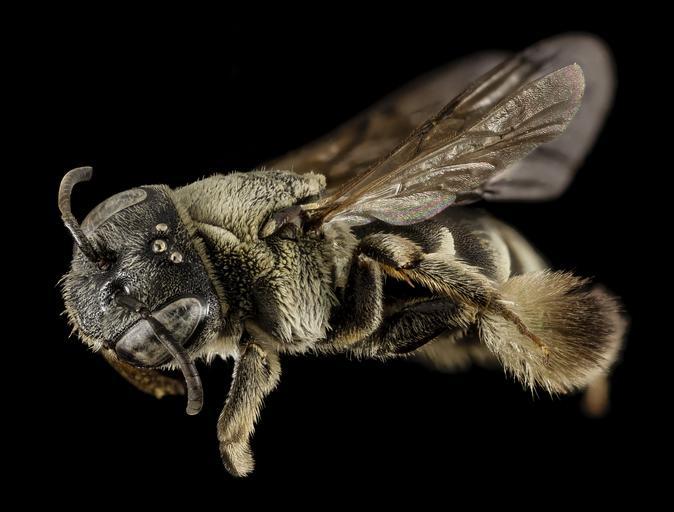MAKE A MEME
View Large Image

| View Original: | bee15274,_f,_turkey,_side_2014-08-14-17.53.52_ZS_PMax.jpg (4504x3421) | |||
| Download: | Original | Medium | Small | Thumb |
| Courtesy of: | www.flickr.com | More Like This | ||
| Keywords: bee biml usgsbiml droege turkey europe zerene stackerstackshot zerenestackerstackshot usgs dustmop apidae scopa pollen carrying hairs pollencarryinghairs hair hairy ancyla asiatica ancylaasiatica taxonomy:binomial=ancyla asiatica taxonomy:binomial=ancylaasiatica ancyla animal black background macro photo border depth of field texture pet cat insect organic pattern hands pattern Ancyla asiatica, Asiatic Enigma Bee collected in Turkey Nine species of Enigma Bees occur from the Western portion of the Mediterranean to Central Asia. They are called Enigma bees because it has been so difficult to decide which other bees they are closely related to. The reason for this confusion lies in their tongues. Bees are classified into long- and short-tongued varieties. Frustratingly, this distinction does not always refer to the length of the tongue but to the details of the structure of the mouthparts. Short-tongued bees have a small segmented structure that lies alongside the actual tongue, long-tongued bees have this structure much elongated seemingly sheathing the real tongue. The actual tongue in long-tongued bees has a stiff rod running along its length, presumably to strengthen it. Short-tongued bees lack this reinforcement. The problem with Enigma bees is that they are related to long-tongued bees but have lost the long-tongue characteristics – no sheath, no rod. The reason they have reverted to an earlier version of bee mouthparts? They visit tiny, open flowers of the parsley family, which need no deep probing. Enigma bees are rare in collections. Only within the last 2 years have the ground nests of two of the species been described, so there is much to be discovered within this group. Unlike the female pictured here the males of this group have prominent white markings on their faces. ~~~~~~~~~~{{{{{{0}}}}}}~~~~~~~~~~ All photographs are public domain, feel free to download and use as you wish. Photography Information: Canon Mark II 5D, Zerene Stacker, Stackshot Sled, 65mm Canon MP-E 1-5X macro lens, Twin Macro Flash in Styrofoam Cooler, F5.0, ISO 100, Shutter Speed 200 Further in Summer than the Birds Pathetic from the Grass A minor Nation celebrates Its unobtrusive Mass. No Ordinance be seen So gradual the Grace A pensive Custom it becomes Enlarging Loneliness. Antiquest felt at Noon When August burning low Arise this spectral Canticle Repose to typify Remit as yet no Grace No Furrow on the Glow Yet a Druidic Difference Enhances Nature now -- Emily Dickinson Want some Useful Links to the Techniques We Use? Well now here you go Citizen: Basic USGSBIML set up: www.youtube.com/watch?v=S-_yvIsucOY USGSBIML Photoshopping Technique: Note that we now have added using the burn tool at 50% opacity set to shadows to clean up the halos that bleed into the black background from "hot" color sections of the picture. www.youtube.com/watch?v=Bdmx_8zqvN4 PDF of Basic USGSBIML Photography Set Up: ftp://ftpext.usgs.gov/pub/er/md/laurel/Droege/How%20to%20Take%20MacroPhotographs%20of%20Insects%20BIML%20Lab2.pdf Google Hangout Demonstration of Techniques: plus.google.com/events/c5569losvskrv2nu606ltof8odo or www.youtube.com/watch?v=4c15neFttoU Excellent Technical Form on Stacking: www.photomacrography.net/ Contact information: Sam Droege sdroege@usgs.gov 301 497 5840 Ancyla asiatica, Asiatic Enigma Bee collected in Turkey Nine species of Enigma Bees occur from the Western portion of the Mediterranean to Central Asia. They are called Enigma bees because it has been so difficult to decide which other bees they are closely related to. The reason for this confusion lies in their tongues. Bees are classified into long- and short-tongued varieties. Frustratingly, this distinction does not always refer to the length of the tongue but to the details of the structure of the mouthparts. Short-tongued bees have a small segmented structure that lies alongside the actual tongue, long-tongued bees have this structure much elongated seemingly sheathing the real tongue. The actual tongue in long-tongued bees has a stiff rod running along its length, presumably to strengthen it. Short-tongued bees lack this reinforcement. The problem with Enigma bees is that they are related to long-tongued bees but have lost the long-tongue characteristics – no sheath, no rod. The reason they have reverted to an earlier version of bee mouthparts? They visit tiny, open flowers of the parsley family, which need no deep probing. Enigma bees are rare in collections. Only within the last 2 years have the ground nests of two of the species been described, so there is much to be discovered within this group. Unlike the female pictured here the males of this group have prominent white markings on their faces. ~~~~~~~~~~{{{{{{0}}}}}}~~~~~~~~~~ All photographs are public domain, feel free to download and use as you wish. Photography Information: Canon Mark II 5D, Zerene Stacker, Stackshot Sled, 65mm Canon MP-E 1-5X macro lens, Twin Macro Flash in Styrofoam Cooler, F5.0, ISO 100, Shutter Speed 200 Further in Summer than the Birds Pathetic from the Grass A minor Nation celebrates Its unobtrusive Mass. No Ordinance be seen So gradual the Grace A pensive Custom it becomes Enlarging Loneliness. Antiquest felt at Noon When August burning low Arise this spectral Canticle Repose to typify Remit as yet no Grace No Furrow on the Glow Yet a Druidic Difference Enhances Nature now -- Emily Dickinson Want some Useful Links to the Techniques We Use? Well now here you go Citizen: Basic USGSBIML set up: www.youtube.com/watch?v=S-_yvIsucOY USGSBIML Photoshopping Technique: Note that we now have added using the burn tool at 50% opacity set to shadows to clean up the halos that bleed into the black background from "hot" color sections of the picture. www.youtube.com/watch?v=Bdmx_8zqvN4 PDF of Basic USGSBIML Photography Set Up: ftp://ftpext.usgs.gov/pub/er/md/laurel/Droege/How%20to%20Take%20MacroPhotographs%20of%20Insects%20BIML%20Lab2.pdf Google Hangout Demonstration of Techniques: plus.google.com/events/c5569losvskrv2nu606ltof8odo or www.youtube.com/watch?v=4c15neFttoU Excellent Technical Form on Stacking: www.photomacrography.net/ Contact information: Sam Droege sdroege@usgs.gov 301 497 5840 | ||||